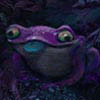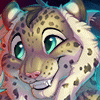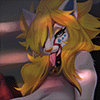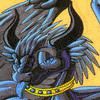
Photoshop and Clip Studio Paint. 50hrs+
If you like my art, please consider becoming a Patron: www.patreon.com/bjpentecost
Or grabbin me a cup of Kofi: ko-fi.com/bjpentecost
I would really appreciate it! Every little bit helps.
You can also follow my FB where I post Work in Progress pieces: https://www.facebook.com/bobbiejean.pentecost
And Twitter where I post everything else from doodles to snippets to step by steps to complete, utter nonsense! https://twitter.com/jean_pentecost
I also occasionally shitpost uppity leftist claptrap. Sorreeeee.
~~~
This is a piece of gift art for someone who shall remain nameless unless he is okay with being outed as the wonderful bastard who sent me monitors and a tablet.
Feel free to ignore all the stuff below. It's for my own use.
…
Gryphonidae
Classification
Members of the gryphonidae family are taxonomically ranked by a number of defining characteristics, the primary ones being physiological, morphological, and genetic. Gryphettes are the smallest members of the gryphonidae family, the largest of which are no larger than a common raven and the smallest of which may be as small as a humming bird. Gryphs are the mid-sized members of the gryphonidae family, ranging in size from domestic cat to large dog. Gryphons, the largest members, are roughly comparable in size to larger breeds of equine, though, a few species may be twice as large. Males of the Pharaoh, Asherath, and Quetzal species may even approach thrice the size of a Clydesdale horse.
Gryphettes, gryphs, and gryphons are also distinguished by other qualities such as vocalization, diet, cognitive capacity, bone composition, and density of the leyoneural complex. Additionally, there exist a number of adjacently-related species classed as "gryphonoid" which are characterized by morphological, physiological, and genetic similarities to gryphonidae species. These may include neepers, callowhops, dhots, gazadoles, and other such species that are similar to gryphons yet appreciably deviant. It's worth noting there are gray areas where some species are difficult to classify.
All gryphonidae species share a number of traits in common, the most obvious ones being a blend of mammalian and avian physiology including feathers, fur, wings, beaks, external ears, and tails. Most species have either quasi or fully opposable thumbs. Some species have retractile claws, others may have horns, and a few have more batlike wings. Gryphonidae is a very diverse family yet all species are no less than 96% genetically similar.
Cognition
One of the key defining traits of gryphonkind is intellect. Even the smallest members possess remarkable cognitive capacity for their size. Button gryphettes, not much larger than a chicken's egg, are able to follow the basic rules of Checkers and can be trained to play. Many species of gryph are smart enough to perform tasks or jobs such as cleaning, delivery, surveillance, and hunting. Some species of gryphon are cognitively comparable to human beings. Most gryphonidae species can recognize themselves in mirrors and are self-aware to varying degrees.
Gryphonidae cognition is contingent to a fair extent on environment, culture, and upbringing. A gryphon that is isolated from any educative processes, socialization, or culture will suffer the same adverse affects as humans raised in similar unfortunate circumstances which is to say that their cognitive function will be stunted.
Sociality
All gryphonidae are social to some extent, though, this varies greatly from species to species and individual to individual. There are virtually no hard, fast rules where gryphonidae sociality is concerned. Gryphettes tend to be the most social and often live in large colonies with elaborate nest networks built amidst canopies. Gryphon sociality is often comparable to that of human beings. Gryphs span the gamut from nearly asocial to tightly-nit groups. Homosexuality, bisexuality, panromanticity, and asexuality have been observed in all documented gryphonidae species.
Communication
Each gryphonidae class tends to have their own unique vocal capabilities. Gryphettes are known for their musical, melodious repertoire and ability to harmonize with each other. Gryphs tend to have a more robust vocabulary including barks, growls, howls, screeches, caterwauls, and ululations. Gryphons are capable of complex speech comparable to human language. Caelesti and Pharaoh gryphons are capable of communicating complex ideas with overlapping vocalizations and gestural body language. It would be somewhat comparable to using sign language while saying something completely different in speech with two or more voices. In this way, they can convey several paragraph's worth of information in mere seconds.
All gryphonidae species are capable of mimicry but some are better than others with gryphs and gryphons tending to be better at it than gryphettes. Aside from vocalizations, gryphonkind communicate to varying degrees with body language which may include assorted gestures, dancing, plumage displays, and the like.
Diet
All gryphons are omnivorous but diets vary widely from species to species with some being more insectivorous or granivorous and others being almost entirely carnivorous or herbivorous. All species are opportunistic carnivores and will not pass up a chance at meat even if they are not especially inclined to seek out meat.
Reproduction
Gryphonidae reproduction is almost as varied as the family itself; some females lay hard-shelled eggs, others lay soft-shelled eggs, some birth live young, some have marsupial pouches, some give birth to liters of up to eight while others may only give birth to one or two. Gryphons and gryphs have cubs while gryphette young are called pips.
Ecology
Gryphonidae species can be found in any habitat around the world from desert to tundra to forest to city to beaches and everything in between. That being said, certain species do tend to prefer certain habitats. Larger species tend to prefer open savannah or mountain while smaller species favor forest and jungle. Several species burrow and some are cave-dwelling. Gryphettes and smaller gryphs do well in cities and towns.
Flight
All gryphonidae species possess leyoneural complexes which allow them to interface with long wavelength aleythir (ley). This grants the ability to fly, glide, float, and such. The nature of their leyoneural complexes is such that they are typically not capable of performing elaborate or complicated tasks via the ley such as telekinesis or mind-reading. Instead, their simplified leyoneural networks allow them to hold their weight aloft in the ley like a fish swimming through water. As such, even larger species of gryphon can take flight.
If you like my art, please consider becoming a Patron: www.patreon.com/bjpentecost
Or grabbin me a cup of Kofi: ko-fi.com/bjpentecost
I would really appreciate it! Every little bit helps.
You can also follow my FB where I post Work in Progress pieces: https://www.facebook.com/bobbiejean.pentecost
And Twitter where I post everything else from doodles to snippets to step by steps to complete, utter nonsense! https://twitter.com/jean_pentecost
I also occasionally shitpost uppity leftist claptrap. Sorreeeee.
~~~
This is a piece of gift art for someone who shall remain nameless unless he is okay with being outed as the wonderful bastard who sent me monitors and a tablet.
Feel free to ignore all the stuff below. It's for my own use.
…
Gryphonidae
Classification
Members of the gryphonidae family are taxonomically ranked by a number of defining characteristics, the primary ones being physiological, morphological, and genetic. Gryphettes are the smallest members of the gryphonidae family, the largest of which are no larger than a common raven and the smallest of which may be as small as a humming bird. Gryphs are the mid-sized members of the gryphonidae family, ranging in size from domestic cat to large dog. Gryphons, the largest members, are roughly comparable in size to larger breeds of equine, though, a few species may be twice as large. Males of the Pharaoh, Asherath, and Quetzal species may even approach thrice the size of a Clydesdale horse.
Gryphettes, gryphs, and gryphons are also distinguished by other qualities such as vocalization, diet, cognitive capacity, bone composition, and density of the leyoneural complex. Additionally, there exist a number of adjacently-related species classed as "gryphonoid" which are characterized by morphological, physiological, and genetic similarities to gryphonidae species. These may include neepers, callowhops, dhots, gazadoles, and other such species that are similar to gryphons yet appreciably deviant. It's worth noting there are gray areas where some species are difficult to classify.
All gryphonidae species share a number of traits in common, the most obvious ones being a blend of mammalian and avian physiology including feathers, fur, wings, beaks, external ears, and tails. Most species have either quasi or fully opposable thumbs. Some species have retractile claws, others may have horns, and a few have more batlike wings. Gryphonidae is a very diverse family yet all species are no less than 96% genetically similar.
Cognition
One of the key defining traits of gryphonkind is intellect. Even the smallest members possess remarkable cognitive capacity for their size. Button gryphettes, not much larger than a chicken's egg, are able to follow the basic rules of Checkers and can be trained to play. Many species of gryph are smart enough to perform tasks or jobs such as cleaning, delivery, surveillance, and hunting. Some species of gryphon are cognitively comparable to human beings. Most gryphonidae species can recognize themselves in mirrors and are self-aware to varying degrees.
Gryphonidae cognition is contingent to a fair extent on environment, culture, and upbringing. A gryphon that is isolated from any educative processes, socialization, or culture will suffer the same adverse affects as humans raised in similar unfortunate circumstances which is to say that their cognitive function will be stunted.
Sociality
All gryphonidae are social to some extent, though, this varies greatly from species to species and individual to individual. There are virtually no hard, fast rules where gryphonidae sociality is concerned. Gryphettes tend to be the most social and often live in large colonies with elaborate nest networks built amidst canopies. Gryphon sociality is often comparable to that of human beings. Gryphs span the gamut from nearly asocial to tightly-nit groups. Homosexuality, bisexuality, panromanticity, and asexuality have been observed in all documented gryphonidae species.
Communication
Each gryphonidae class tends to have their own unique vocal capabilities. Gryphettes are known for their musical, melodious repertoire and ability to harmonize with each other. Gryphs tend to have a more robust vocabulary including barks, growls, howls, screeches, caterwauls, and ululations. Gryphons are capable of complex speech comparable to human language. Caelesti and Pharaoh gryphons are capable of communicating complex ideas with overlapping vocalizations and gestural body language. It would be somewhat comparable to using sign language while saying something completely different in speech with two or more voices. In this way, they can convey several paragraph's worth of information in mere seconds.
All gryphonidae species are capable of mimicry but some are better than others with gryphs and gryphons tending to be better at it than gryphettes. Aside from vocalizations, gryphonkind communicate to varying degrees with body language which may include assorted gestures, dancing, plumage displays, and the like.
Diet
All gryphons are omnivorous but diets vary widely from species to species with some being more insectivorous or granivorous and others being almost entirely carnivorous or herbivorous. All species are opportunistic carnivores and will not pass up a chance at meat even if they are not especially inclined to seek out meat.
Reproduction
Gryphonidae reproduction is almost as varied as the family itself; some females lay hard-shelled eggs, others lay soft-shelled eggs, some birth live young, some have marsupial pouches, some give birth to liters of up to eight while others may only give birth to one or two. Gryphons and gryphs have cubs while gryphette young are called pips.
Ecology
Gryphonidae species can be found in any habitat around the world from desert to tundra to forest to city to beaches and everything in between. That being said, certain species do tend to prefer certain habitats. Larger species tend to prefer open savannah or mountain while smaller species favor forest and jungle. Several species burrow and some are cave-dwelling. Gryphettes and smaller gryphs do well in cities and towns.
Flight
All gryphonidae species possess leyoneural complexes which allow them to interface with long wavelength aleythir (ley). This grants the ability to fly, glide, float, and such. The nature of their leyoneural complexes is such that they are typically not capable of performing elaborate or complicated tasks via the ley such as telekinesis or mind-reading. Instead, their simplified leyoneural networks allow them to hold their weight aloft in the ley like a fish swimming through water. As such, even larger species of gryphon can take flight.
Category All / All
Species Gryphon
Size 1728 x 1148px
File Size 1.2 MB
Surprisingly, Derpy was much more easy for me to find here!
And yes, I had to read zyrenia's comment to realize they were all gryphons, I love that idea!!!
zyrenia's comment to realize they were all gryphons, I love that idea!!!
Stunning work as always, I don't say it enough but I think it every time
And yes, I had to read
 zyrenia's comment to realize they were all gryphons, I love that idea!!!
zyrenia's comment to realize they were all gryphons, I love that idea!!!Stunning work as always, I don't say it enough but I think it every time
http://prntscr.com/pv52uk
(~23 seconds; no hints gleaned from comments
)
i wanna be a gryphon!
you (as is your usual) make ´em look cool, bobbie-jean!
there you go!
how did you like making another arte, this one with motion blurring?
shee-it.
i'd ... ... i'd make this my desktop if i could.
ah!
as a matter of fact. . . . .
(~23 seconds; no hints gleaned from comments
)
i wanna be a gryphon!
you (as is your usual) make ´em look cool, bobbie-jean!
there you go!
how did you like making another arte, this one with motion blurring?
shee-it.
i'd ... ... i'd make this my desktop if i could.
ah!
as a matter of fact. . . . .
Turned out very nice. Very nice indeed.
I like when folks use Motion Blurring and / or Depth of Field in their work.
( Some balk at the idea of blurring out that which they spent so much time on )
Curious how you stay focused on a piece for such a long period of time.
As for the hardware, I'm sure they're happy that someone found a use for it vs
sitting in the closet collecting dust for who know how long :P
Btw - Derpy was rather easy to find this time considering the areas in which he
can hide is rather limited by the color palette in use :D
I like when folks use Motion Blurring and / or Depth of Field in their work.
( Some balk at the idea of blurring out that which they spent so much time on )
Curious how you stay focused on a piece for such a long period of time.
As for the hardware, I'm sure they're happy that someone found a use for it vs
sitting in the closet collecting dust for who know how long :P
Btw - Derpy was rather easy to find this time considering the areas in which he
can hide is rather limited by the color palette in use :D

 FA+
FA+




























Comments